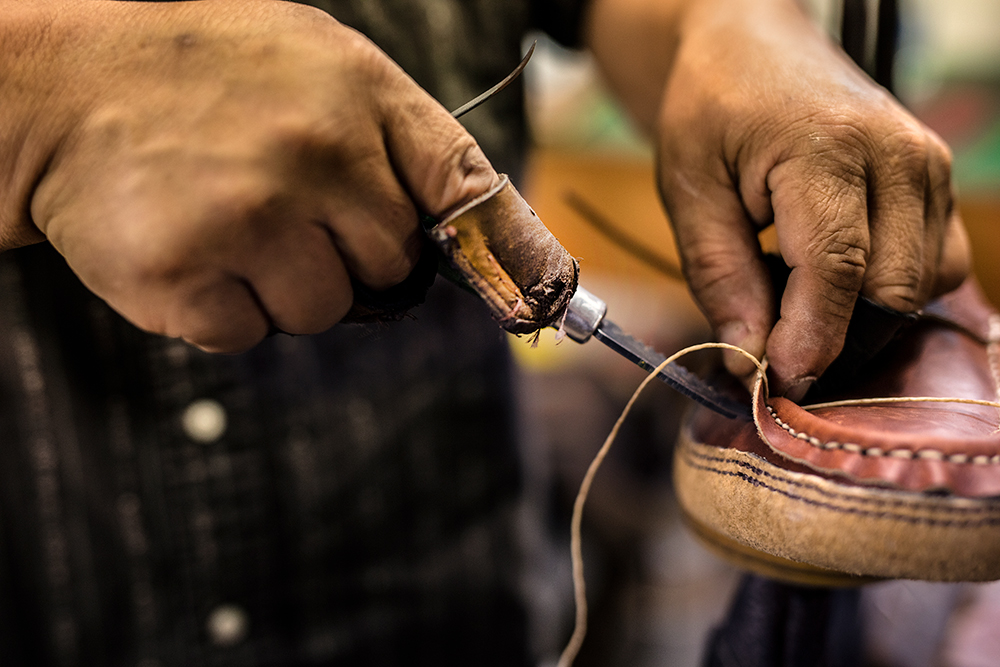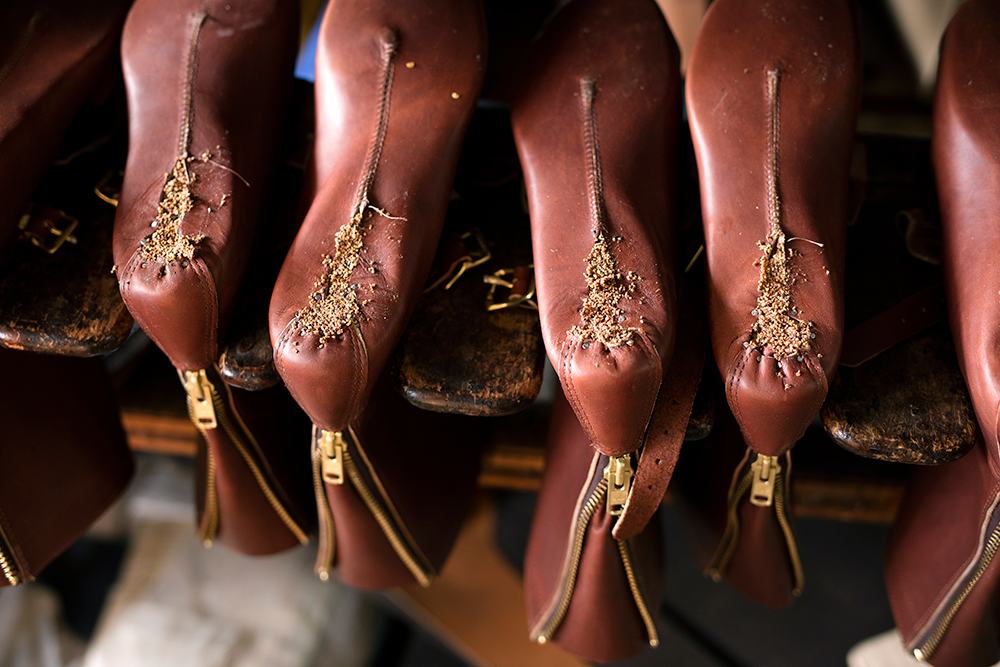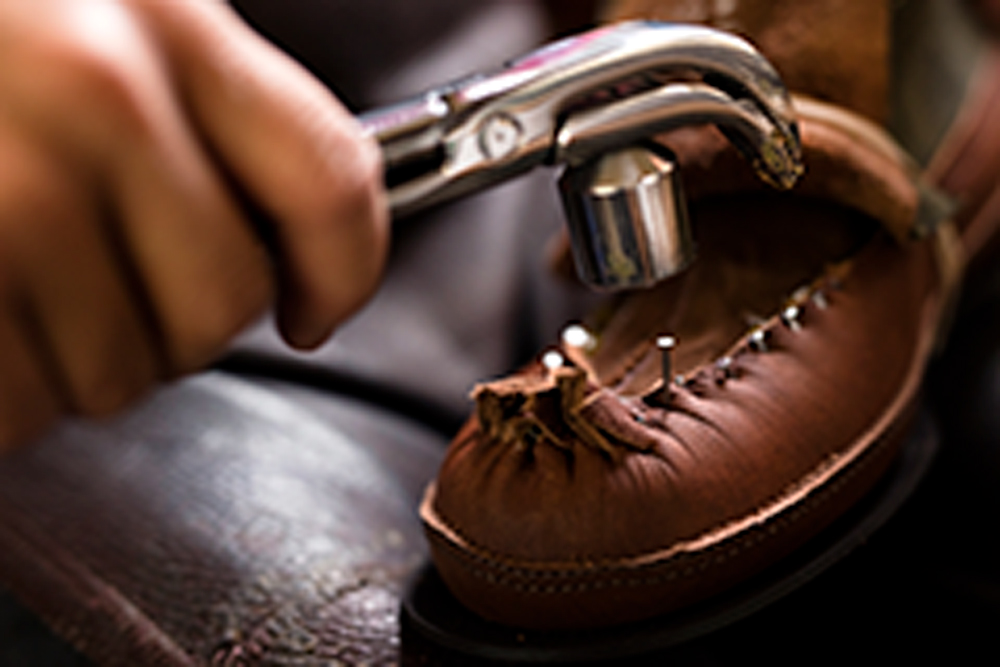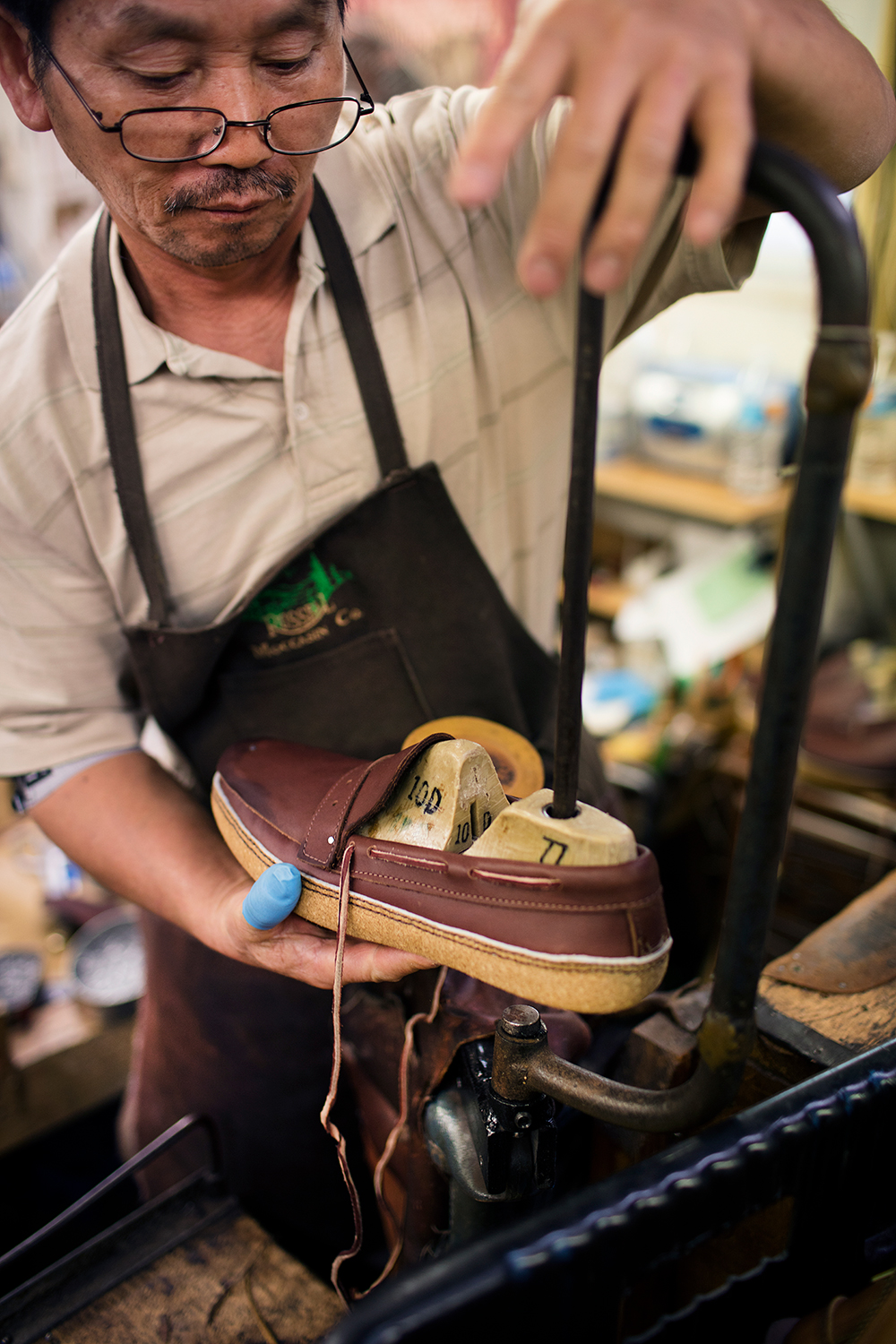The Russell Way

In his classic essay, “Quality,” the Nobel laureate John Galsworthy chronicles his relationship with a pair of German-born bootmakers, the Gessler brothers, who had a small shop in London’s West End. The Gesslers had made boots for Galsworthy’s father, and when he himself is “promoted” to them he comes to understand that they hew to an extraordinary standard of craftsmanship.
To make boots as they do seems to him “mysterious and wonderful.” They cannot be hurried, they refuse to compromise, and they take a fierce pride in their work. Whenever he visits their shop to order a new pair, the younger brother not only traces the outlines of his feet but also runs his hands over Galsworthy’s toes and ankles, committing their contours to memory to ensure that the leather is cut to fit like a second skin.
Indeed, because some “essence of boot” seems to be stitched into the Gesslers’ creations, Galsworthy finds it all but impossible to wear them out. And therein lies the tragic irony at the center of “Quality”: The Gesslers’ boots are too good. They last too long; they cannot be made more rapidly or with less costly materials; their superior craftsmanship is apparent only to a discerning few. As a guiding principle this is deeply admirable—but as a business model, it’s a disaster.
Shortly after taking delivery of boots that are as flawless as human hands can make them, Galsworthy learns that the younger brother died within hours of completing them. (The older brother has been deceased for several years at this point.) The younger Gessler reportedly spent his final days in a frenzy of work, not stopping to eat, drink, or rest until his devotion to his craft literally consumed him. Galsworthy keenly feels the loss, but even more than that, he senses that it marks the end of something—something like the passing of an era.

And it is for this passing, not for himself or Herr Gessler, that Galsworthy grieves.
Galsworthy’s allegory for the Philistinism of the modern age was written in 1912. If anything, it resonates more powerfully today than it did a century ago . . . but in an obscure and otherwise unremarkable town tucked amid the dairy farms, woodlots, and marshlands of east-central Wisconsin, in a nondescript building whose architectural style can only be described as early Cold War, a small group of men and women continue to create made-to-measure footwear of peerless quality. The spiritual descendants of the Gessler brothers, their skill, dedication, and fidelity to the highest ideals of craftsmanship set them, and their products, apart—and make their employer, the W. C. Russell Moccasin Co., one of the most respected and even revered names in the iconography of the outdoors.
Since the founding of W. C. Russell Moccasin in 1898 (although its roots can be traced all the way back to 1850), the company has shod the powerful, the influential, and the famous—presidents, kings, Hollywood royalty, military leaders, captains of industry. For parts of three centuries, the men who stride the earth like giants have come to Russell for the boots—also the shoes, slippers, and, yes, moccasins—in which they’ve made their footprints.
When Charles Lindbergh emerged from the Spirit of St. Louis after his historic trans-Atlantic flight, the first things to touch the tarmac in Paris were the soles of his Russell moccasins. When Edward, Prince of Wales (later King Edward VIII, he of abdication infamy) went on safari with Denys Finch-Hatton (the lover of Karen Blixen and Beryl Markham), Russell stalking boots kept him in the hunt.
Russells are worn at home and in the office, at camp, in the cabin, on boats, trains, and planes, anywhere and everywhere there is a demand and a desire for uncommonly comfortable, durable, handsome footwear. To wear Russells is to make a statement—a statement about one’s values and sensibilities, about the way you roll. Is there a cachet to wearing Russells? Better believe there is—and if it smells like old money and oiled leather, well, so be it.
Still, despite the increasing popularity of “street-stylish” Russells among the young, hip, and newly affluent (there’s an almost cult-like vogue for black Russell boots in Japan), the company’s heart and soul remain where they’ve always been: in the field, on the feet of sportsmen. That’s where the legend of Russell handsewns began, where the Russell reputation was built, step-by-step and testimonial-upon-testimonial, and where its focus will always come to rest. No company is more responsive to its clientele than Russell, and the core of that clientele is, and always has been, hunters.
That’s never been in dispute. Perusing the Russell catalog, the mind reels. The range of styles designed for specific hunting applications, from plains game in Africa to sheep in the crags of the high country, is dizzying. Clearly, though, the needs of upland bird hunters rank first and foremost.
Ladies and gentlemen, step up to the Russell buffet.

If I count correctly, Russell’s signature Bird Shooter line alone encompasses eight different boots. There’s the nearly puncture-proof Prickly Pear Bird Shooter, designed to withstand the thorns, snakes, and assorted other nasties of Texas quail country; the durable South Forty Bird Shooter II, a great choice for long days spent kicking rooster pheasants out of heavy CRP; the high-topped Gentleman’s Classic Bird Shooter for tradition-conscious sportsmen looking to channel their inner Havilah Babcock; and on and on and on. All are made-to-measure; most are available with a choice of soles; some can be ordered with special leathers or with a double vamp for additional water-resistance. Have a nice tanned hide from an animal you harvested? If it meets their specifications, Russell can make you a pair of boots from it.
The specifications of the final product aside, every Russell boot begins life as a moccasin. This “true moccasin construction,” as the company calls it—and the unsurpassed comfort it provides, literally cradling the foot in a hammock of leather—has been a Russell hallmark from the beginning. And if not quite from the beginning, since 1910 Russell has employed a special stitching technique, the double lock, that significantly improves strength, durability, and water-resistance.
Little wonder that the 1919 Russell catalog proclaimed “Highest grade moccasin footwear for the hunter, trader, trapper, surveyor, canoeist and for every outdoor calling . . . ” While there probably aren’t as many traders and trappers wearing Russells these days (although you might be surprised), the statement’s essence—and the unmistakable note of pride it conveys—still ring vibrantly true.

One day last summer I picked up my longtime hunting partner, Erik Forsgren, for the short drive from his home in Fremont, Wisconsin, to the Russell facility in Berlin. (The Wisconsin town of Berlin, by the way, is pronounced with the accent on the first syllable, a change effected by the city fathers during World War I in response to the virulent anti-German sentiment that prevailed at the time.) A second-generation Russell customer whose 95-year-old father “lives in his Oneida Moccasins,” Erik was wearing the brown Tassle Loafers that are one of the nine pairs of Russells he currently owns.
The Russell building, a low-slung concrete- and glass-block structure garnished with ivy, stands a block off Berlin’s main drag. Other than a carved wooden sign bearing the company name and logo, it doesn’t call attention to itself.
“A lot of people drive right past,” Joe Gonyo, Russell’s V.P. for Operations, says with a laugh. “They’re looking for a factory. Well, as you can see, we’re the furthest thing from a factory. We have 30 employees, and this year we’re on pace to make between 9,500 and 10,000 pairs of boots.” A Berlin native and inveterate outdoorsman (“I always joke that if I go grouse hunting, I’m ‘field-testing’”), Gonyo grew up in his family’s glove-making business. He worked for Russell for a number of years and then left for a time, only to be lured back when he was offered an ownership stake by the company’s President, Ralph “Lefty” Fabricius.
A living legend who’s truly the face of W.R. Russell Moccasin, Lefty’s career began in the mid-1950s. (Yes, you read that right.) The owner at the time was Bill Gustin, who’d purchased the company in 1928. He continued as President until Lefty—who married Gustin’s daughter, Judy, in 1957—succeeded him in the mid-1980s. All of which is a roundabout way of saying that for a span of close to 90 years, Russell has been helmed by just two men. Such continuity of leadership is remarkable (if not completely unheard of), and it accounts in no small measure for Russell’s ability to keep its eye on the ball, play to its strengths, and resolutely adhere to the values that have made it what it is.
“Honestly,” says Gonyo, “money isn’t what drives Lefty. It’s our customers, and the people who work here, and the product we make. That’s why he comes in every day. And I don’t mean Monday through Friday. I mean seven days a week.
“He’s an amazing guy,” Gonyo continues. “We’ll get a pair of boots in for repair that are forty or fifty years old, and just by looking at the stitching Lefty can tell you the name of the person who made them.”
Now, as Gonyo leads us down the cramped, cluttered aisles of the Russell workshop, the air so redolent of leather you could bottle it, we pass artisans bending to tasks that have defined the bootmaker’s art for hundreds of years—shaping, stretching, tacking, stitching, trimming. The tools they employ are equally arcane, and at some point it occurs to me that if there is such a thing as a Time Machine, we’re in it.


The Russell building, a low-slung concrete- and glass-block structure garnished with ivy, stands a block off Berlin’s main drag. Other than a carved wooden sign bearing the company name and logo, it doesn’t call attention to itself.
The Gessler brothers could take a seat at any of the workbenches and, unless the usual occupant happened to leave his or her iPod and earbuds lying around, feel right at home. If you turned a corner to see Bob Cratchit hunched over his vellum ledgers, dipping his quill into a pot of ink by the smoky flicker of a whale-oil lamp, it wouldn’t surprise you at all. This Dickensian feel is only reinforced by some of the sewing machines used to attach midsoles to soles. Black and vaguely sinister, they appear to predate the Industrial Revolution.
“They still work great,” Gonyo says with a shrug. “A new machine would cost $15,000, and it wouldn’t do the job any better.”
Everywhere you look there are bins of lasts (the forms on which footwear is constructed); racks of boots awaiting completion according to the instructions on their handwritten order cards; rolls of leather in rich browns, tans, and burgundies. The wooden file cabinets that hold Russell’s 50,000-plus customer information cards—alphabetized by state, of course—are exactly the same as the ones those of us of a certain age searched to find library books, once upon a time.

After we’ve completed our tour, Gonyo sticks his head around a partition and summons Suzie Fabricius. The V.P. for Sales and Marketing, she, Joe, and Lefty (her father, in case you’re wondering) comprise the whole of Russell’s management team. A top-heavy operation, it ain’t.
Lefty’s in Oshkosh for a dentist’s appointment, so we commandeer his office—maybe the only space in the building big enough for four people to comfortably sit down—for a few minutes of question and answer. I tell Joe and Suzie that I really have just one question: How does a company that runs on a 19th Century business model survive and prosper in the digital age?
“Well, we’ve kind of entered the digital age,” Gonyo says with a laugh. “Thanks to Suzie, we’re now on Facebook and Twitter.”
“It’s true that our production process is primitive by modern standards,” Suzie Fabricius acknowledges, “but that’s the way it has to be done. It can’t be speeded up. There’s no mass production. We could never do that. That’s not who we are. And you can’t just pull someone off the street and teach them how to do this. It’s not just a job—it’s a craft. You have to take pride in it, and our people do.”
I mention how ironic it seems that “artisanal” is the new buzzword—and that Russell has never been anything but artisanal.
“That’s exactly right,” says Gonyo. “You can point to a lot of reasons for our longevity, but that’s the biggest one: the craftsmanship.”
Indeed. Russell boots are not inexpensive, and it’s a common reaction, upon seeing their prices, to wonder how they can charge so much. Once you’ve witnessed all the steps that go into the creation of a Russell boot, though—and particularly after you’ve witnessed the skill, the care, and the attention to detail that their craftspeople lavish on every pair—you find yourself wondering how they can charge so little.
A hundred years ago John Galsworthy mourned for something he feared had been irretrievably lost. But it hadn’t been lost—it had only changed its address. And I’m delighted to report that in a sleepy little town in Wisconsin, it’s alive and well.
























